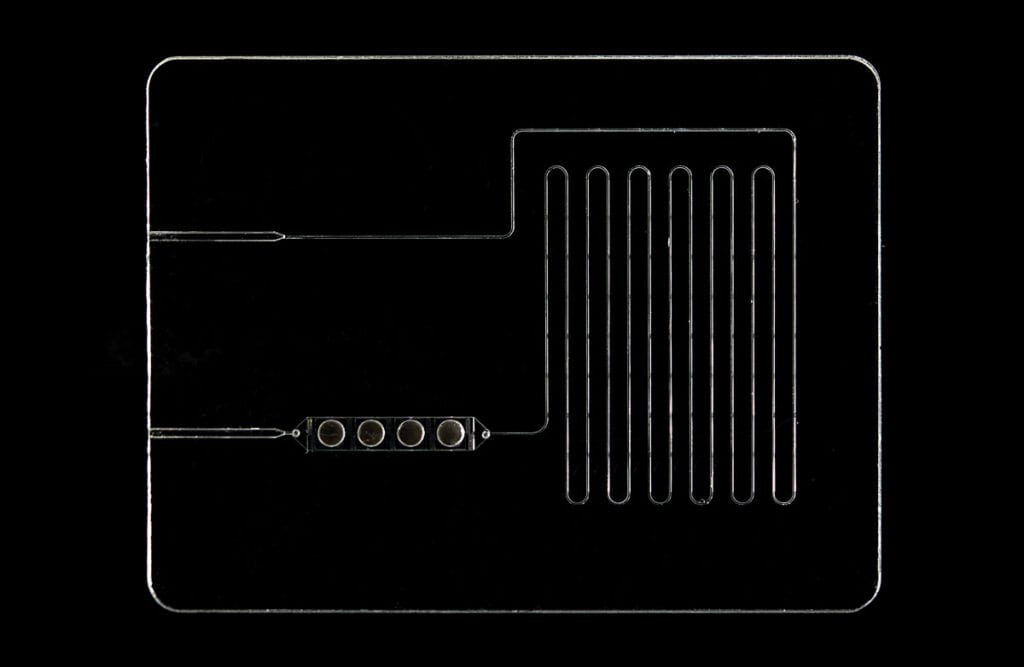Microfluidics and microfluidic devices are being used now more than ever before. One of the most common applications of microfluidics is in single-cell isolation and genome sequencing. The unique properties and capabilities of microfluidic systems has provided an opportunity to explore and screen several hundreds of thousands of cells in a few minutes or hours, with significantly less reagents. In this post, we’ll cover droplet microfluidic chip design and droplet chip fabrication. Let’s get started.
Droplet-Based Microfluidic Systems
Droplet-based microfluidic systems are becoming established as valuable tools for various applications, particularly in the chemical and biological research sectors. Single-cell genomic sequencing has recently emerged as a powerful tool for mapping cellular heterogeneity in both diseased and healthy tissues. Droplet microfluidics is among the most promising candidates for capturing and processing thousands of these individual cells for whole-transcriptome or genomic analysis in a massively parallel manner with minimal reagent use.
An advantage that droplet based microfluidics has when compared with conventional analysis or screening methods, is that the droplet provides teh ability to link genotype with phenotype through compartmentalization since each droplet acts as an isolated reactor the encoses indivual cells. These isolated cells can then be easily manipulated, and genomic information is easily extracted, leaving behind molecules of interest trapped inside the droplet, ripe for analysis and sorting.

Droplet Microfluidic Chip Design
In order to get the most of our a droplet microfluidic system, the microfluidic chip needs to be designed as a “droplet generator.” Droplets are typically generated by creating two liquid phases, one of which is an oil phase and the second of which is typically an aqueous phase. One of the phases is designated by the designer as the continuous phase while the other is the dispersed phase. Droplets are produced by incorporating channels and features in the microfluidic device that create the required hydrodynamic conditions for droplet formation, and the droplet formation process depends strongly on the interaction of flow rate, liquid physical properties and the geometry of the features on the chip.
The feature designs are typically classified as “co-flow”, “cross flow” and “flow focusing”. Co-flow is achieved using coaxial microchannels where the continuous phase flows in an outer concentric channel and the dispersed phase flows in the inner channel, both in the same direction. In the crossflow design the dispersed and continuous phases meet at an angle formed by fabricating intersecting microfluidic flow channels. The most common case is the T-junction, where dispersed and continuous phases converge in perpendicular channels. Other microfluidic channel designs for producing droplets via crossflow include the “K-junction” and the “V-junction”. Finally flow focusing designs incorporate a microfluidic contraction region through which coaxial immiscible streams flow and subsequently exit to a single microchannel resulting in the creation of uniform droplets. This method allows for making very small droplets as the formation process is closely related to the size of the narrow contraction.
Droplet Chip Fabrication
Advanced microfabrication technologies enable the flexible design of droplet microfluidic chips. Once the design has been finalized, it can be scaled up in volume and scaled down in cost by using microreplication. There remains a large window for innovation in the area of droplet microfluidics and laboratories across the globe continue to identify new applications for this technology. Single-cell analysis using droplet microfluidics are likely to evolve together with advances in DNA and
RNA sequencing, amplification and expression technologies.
Citrogene: Microfluidic Device Manufacturer
Microfluidics has a multitude of applications across a wide variety of industries. When it comes to producing the ideal microfluidic device for your specific needs, there’s only one microfluidic partner to consider: Citrogene. Our proprietary process allows us to create precise, customized, state-of-the-art microfluidic devices based on your needs, all produced in glass. Contact us today to learn more.
